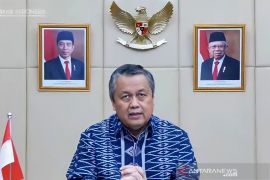"Fitch expects sustained economic growth and fiscal discipline to allow the credit profile to strengthen during 2012 and 2013. Indonesia`s economy is on course to grow by 6,5 percent in 2011 and by 6 percent in 2012," Philip McNicholas, Fitch Ratings Asia Pacific on sovereign debts said here on Tuesday.
Fitch upgraded Indonesia`s debt rating from "BB" to "BBB-" last December 15, 2011 as reflected in Indonesia`s strong and resilient economic growth, low and declining public debt ratios, strengthened external liquidity and a prudent overall macro policy framework.
Fitch considered Indonesia`s domestically oriented economy and success in delivering growth without creating external imbalances or a reliance on short-term financing suggests economic growth prospects should prove resilient to external shocks as in 2008.
The rise in the investment rate to 32.5 percent of GDP in 2010 from 24.9 percent in 2007 had been key to this strong growth outlook.
Substantial reserve accumulation that reached USD 111.3 billion at end-November 2011 from USD 69.6 billion in January 2010 had insulated the sovereign debts during periods of intensified portfolio capital flow volatility.
Andrew Steel, Managing Director, Head of Asia Pacific Corporate Ratings Group Fitch Ratings added that foreign investors became really interested in Indonesia after improvements in Indonesia`s economy in 2008.
"The investors are really interested in Indonesia, 1 or 1.5 years ago they were just interested in China but now they see the scale of Indonesia`s economy," said Andrew.
But to attract more investors, Indonesia needs to focus on infrastruture improvement, he said.
"Infrastruce is the key to attracting investment, investors` demands from time to time tend to focus on utilities companies, since to invest in infrastructure means a lot of capital expenditure and long term payments," he said.
But Indonesia still had structural weaknesses, including underdevelopment, and low per capita income at USD 3,600 compared with a `BBB` range median of USD 9,700, deficiencies in physical infrastructure and corruption. These conditions were weighing on Indonesia`s economic fundamentals and sovereign credit profile.
Indonesia`s fiscal revenue was also still 15.9 percent of GDP in 2010 and this wasbelow the `BBB` group median of 33 percent. Low revenue and heavy budgetary commitment to subsidy programmes constrained capital spending, diminish fiscal flexibility and expose the budget to risks from commodity price vitality.
At the same time, the Indonesian government needed to be more effective in allocation and implementation of expenditures that may bolster economic growth and give an additional lift to revenue collection. (*)
Editor: Kunto Wibisono
Copyright © ANTARA 2012







